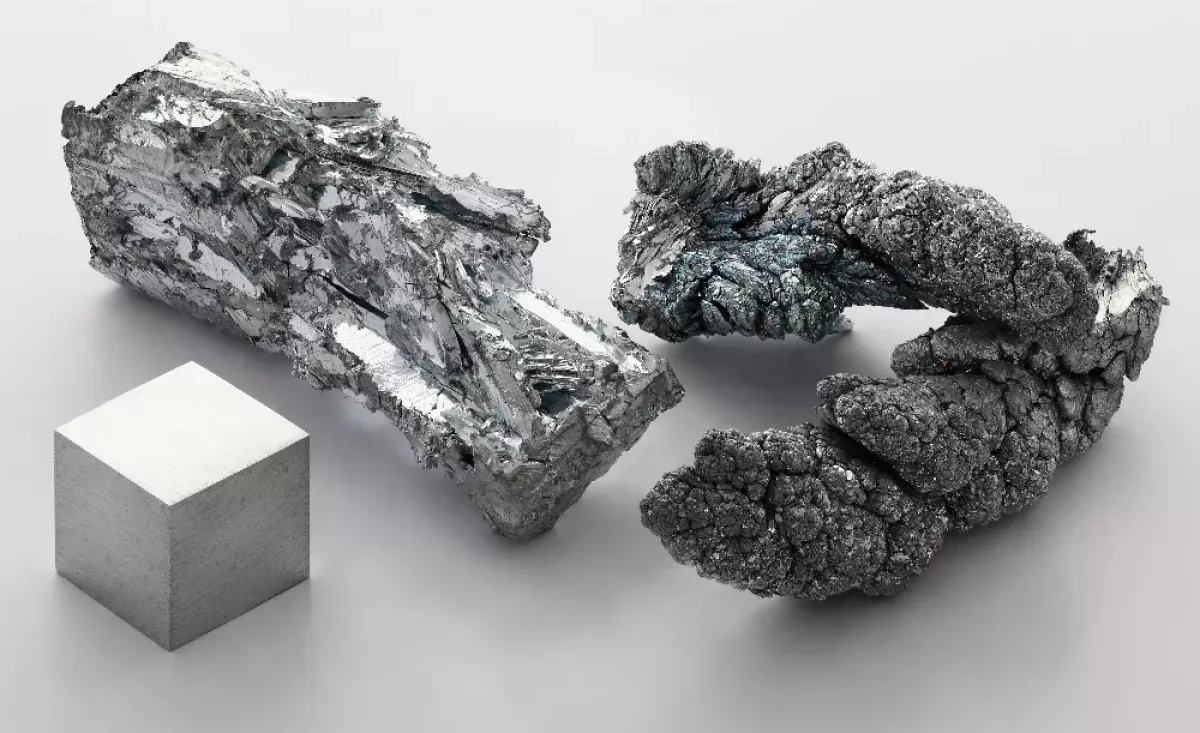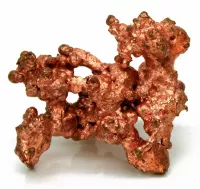Zinc is a chemical element with the symbol Zn and atomic number 30. It is a bluish-gray metal found in the Earth's crust and is often extracted from sphalerite, a zinc sulfide mineral. It is the first element in group 12 (IIB) of the periodic table. Zinc shares chemical similarities with magnesium, as both possess a normal oxidation state of +2 and similarly sized ions. Industrially, zinc is refined using methods like froth flotation, roasting, and electrowinning.
1940: Zinc's Role in Carbonic Anhydrase
A significant breakthrough in 1940 revealed that the enzyme carbonic anhydrase, crucial for removing carbon dioxide from the blood, contains zinc in its active site.
1955: Zinc Identified in Carboxypeptidase
Further solidifying zinc's importance in biochemistry, the digestive enzyme carboxypeptidase was identified as the second zinc-containing enzyme in 1955.
1979: Exploration of Zinc for Anorexia Treatment
Research on utilizing zinc to treat anorexia began in 1979, opening up new avenues for addressing this eating disorder.
1982: Zinc Toxicity Risk Emerges from Ingestion of Pennies
Following the 1982 change in penny composition to primarily zinc, cases of zinc toxicity emerged from ingestion of these coins, highlighting the potential dangers of accidental or intentional ingestion.
1982: Composition Change in U.S. Pennies Poses Health Risk
Starting in 1982, the composition of U.S. pennies changed to primarily zinc, raising concerns about potential zinc toxicity if ingested due to the high solubility of zinc in stomach acid.
1982: Introduction of Zinc Cores in US Pennies
The United States introduced zinc cores in their one-cent coins (pennies) in 1982, marking a change in the coin's composition. These cores are coated with copper for appearance.
1990: Start of USGS Data Collection on Zinc Production
The United States Geological Survey (USGS) began collecting data on refined zinc production in 1990, marking the start of a period of study on zinc trends.
1994: Zinc's Impact on Body Mass Increase in Anorexia Nervosa
A clinical trial conducted in 1994 demonstrated that zinc supplementation could double the rate of body mass increase in individuals undergoing treatment for anorexia nervosa.
1994: Zinc Consumption for US Penny Production
A substantial amount of zinc, 33,200 tonnes (36,600 short tons), was used in 1994 for the production of 13.6 billion pennies in the United States.
1998: Review Examines Zinc Absorption from Different Supplements
A 1998 review investigated the absorption of zinc from various supplemental forms, finding that zinc oxide and zinc carbonate were poorly absorbed compared to zinc acetate and sulfate salts.
2000: Recording High Zinc Levels in Soil Samples
In 2000, soil samples revealed alarmingly high zinc levels, reaching 2000 ppm to 180,000 ppm (18%), highlighting the impact of zinc contamination from various sources.
2001: U.S. Institute of Medicine Updates Dietary Recommendations for Zinc
In 2001, the U.S. Institute of Medicine (IOM) updated the Estimated Average Requirements (EARs) and Recommended Dietary Allowances (RDAs) for zinc, providing guidance for adequate zinc intake across different age groups and life stages.
2002: Estimation of Total Zinc Extracted
By 2002, it was estimated that approximately 346 million tonnes of zinc had been extracted throughout history.
2003: Review Supports Fortification of Cereals with Zinc Oxide
A 2003 review recommended fortifying cereals with zinc oxide, suggesting it as a cost-effective and easily absorbed source of zinc.
2005: Arctic Troposphere Study on Zinc Emissions
A 2005 study focusing on the Arctic troposphere revealed that despite a decrease in global zinc emissions in the 1990s, the concentrations in this region did not reflect this decline.
2005: Study Finds No Significant Differences in Absorption Between Zinc Compounds in Fortified Tortillas
In 2005, a study explored the absorption of different zinc compounds (including oxide and sulfate) added to maize tortillas, finding no significant differences in absorption between them.
2007: Trial Highlights Risks of High-Dose Zinc Supplementation in Elderly Men
A 2007 clinical trial revealed that elderly men taking high doses (80 mg) of zinc supplements experienced increased hospitalizations for urinary complications compared to those taking a placebo, underscoring the potential risks of excessive zinc intake.
June 2009: USFDA Warning on Intranasal Zinc
The US Food and Drug Administration (USFDA) issued a warning in June 2009 advising consumers against using intranasal zinc due to the potential risk of losing their sense of smell.
June 16, 2009: FDA Removes Zinc-Based Intranasal Cold Products from Market Due to Risk of Anosmia
On June 16, 2009, the U.S. FDA took action to remove intranasal zinc cold products from the market due to the risk of anosmia (loss of smell), a potentially serious side effect.
2009: Industrial Applications of Zinc Compounds
In 2009, approximately 25% of the total zinc output in the United States was directed towards the production of various zinc compounds, highlighting their significance in industrial applications.
2009: Reserve Base Estimation for Zinc
In 2009, the most recent reserve base estimation for zinc, considering factors like mining practices, was determined to be approximately 480 Mt.
2009: Dominance of Galvanization in Zinc Usage
In the United States during 2009, a significant portion (55% or 893,000 tons) of zinc metal was primarily utilized for galvanization, a process protecting iron or steel from corrosion.
2010: End of USGS Data Collection Period on Zinc Production
The United States Geological Survey (USGS) concluded a period of data collection, showing an 80% increase in refined zinc production between 1990 and 2010.
2013: NHANES Survey Reports Zinc Consumption in the United States
The National Health and Nutrition Examination Survey (NHANES) 2013–2014 collected data on zinc consumption in the U.S., reporting average intakes for adults and highlighting age-related trends.
2014: Prevalence of the Waelz Process
By 2014, the Waelz process became the dominant method (90%) for recovering zinc from dust generated during the recycling of galvanized steel in electric arc furnaces.
2014: China's Dominance in Global Zinc Production
In 2014, China emerged as a leading producer in the global zinc market, contributing to 38% of the world's total zinc output.
2014: NHANES Survey Reports Zinc Consumption in the United States
The National Health and Nutrition Examination Survey (NHANES) 2013–2014 collected data on zinc consumption in the U.S., reporting average intakes for adults and highlighting age-related trends.
2015: Review Highlighting Zinc's Significance in Human Biology
A comprehensive review conducted in 2015 emphasized the crucial and diverse roles zinc plays in human biological processes, indicating that around 10% of human proteins bind with zinc.
May 27, 2016: Revision of Daily Value for Zinc on Food Labels
On May 27, 2016, the Daily Value (DV) for zinc used on food and supplement labels in the United States was revised from 15 mg to 11 mg, reflecting updated dietary recommendations.
2021: Discovery of ZnBeB11(CN)12
In 2021, a new compound, ZnBeB11(CN)12, provided further evidence of zinc potentially existing in a +3 oxidation state, challenging prior assumptions.
Trending

Adam Thielen is a professional American football wide receiver who most recently played for the Carolina Panthers He is known...
2 months ago Fantasy Football Week 7: Start Jaylen Warren, Sit Chase Brown; Gainwell's Role

24 days ago Mike Tomlin Rumored to Want a Change, Possibly Leaving Steelers After Season.

Christian Kirksey is a former American football linebacker who played in the NFL Kirksey played college football at the University...

2 months ago DK Metcalf Fined by NFL for Unsportsmanlike Conduct Against Packers LB

Bo Nix is an American football quarterback currently playing for the Denver Broncos in the NFL After three seasons with...
Popular

Candace Owens is an American conservative political commentator and author...

Tucker Carlson is an American conservative political commentator known for...

XXXTentacion born Jahseh Dwayne Ricardo Onfroy was a controversial yet...

Ben Shapiro is a prominent American conservative political commentator media...

William Franklin Graham III commonly known as Franklin Graham is...

Bill Gates an American businessman and philanthropist revolutionized personal computing...


